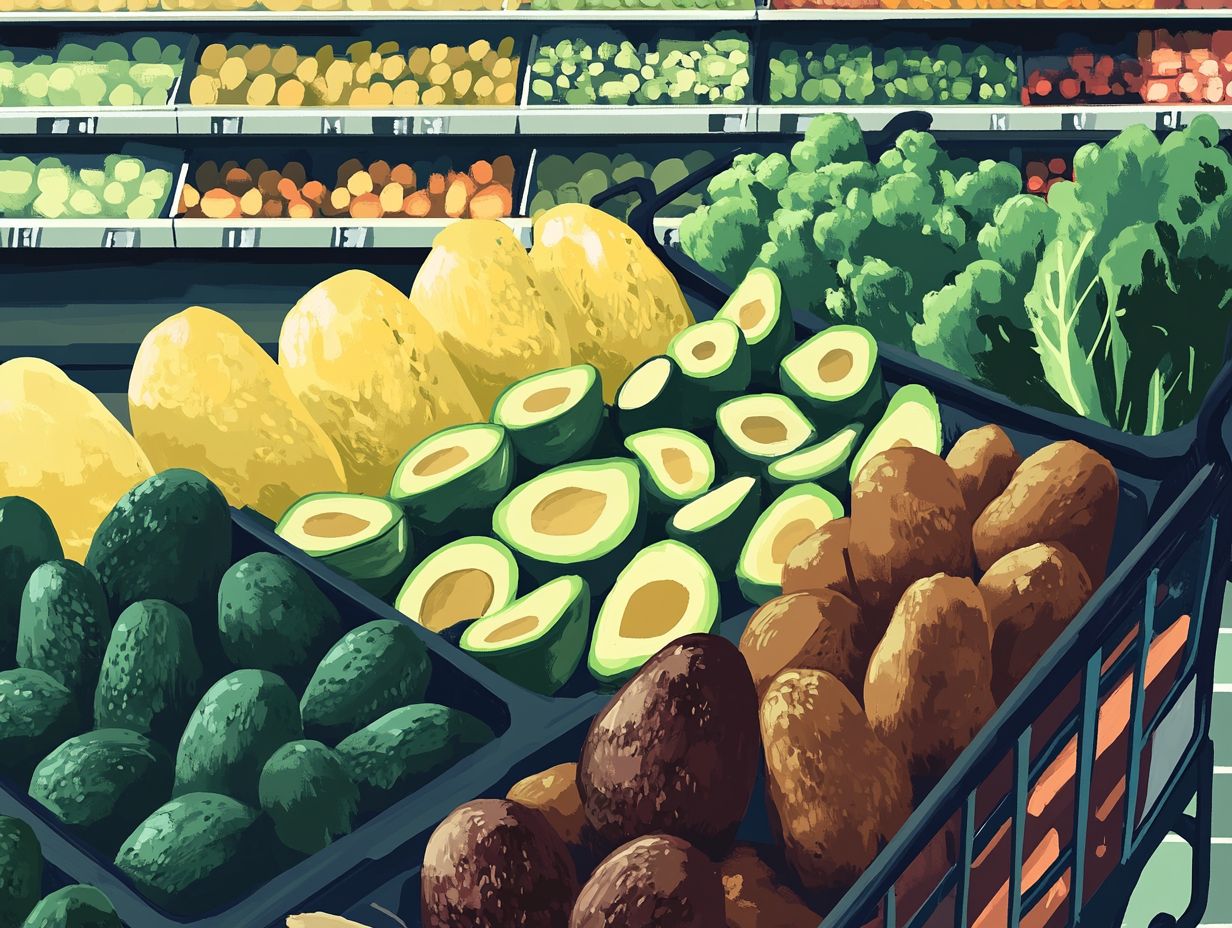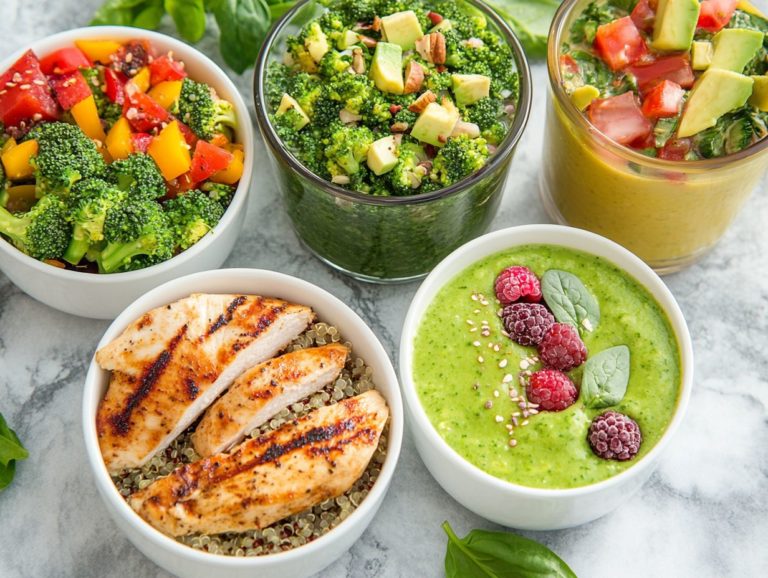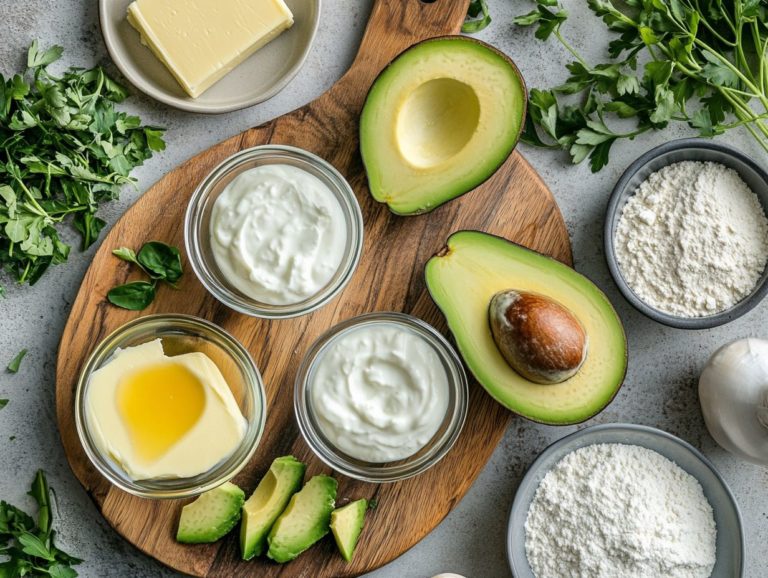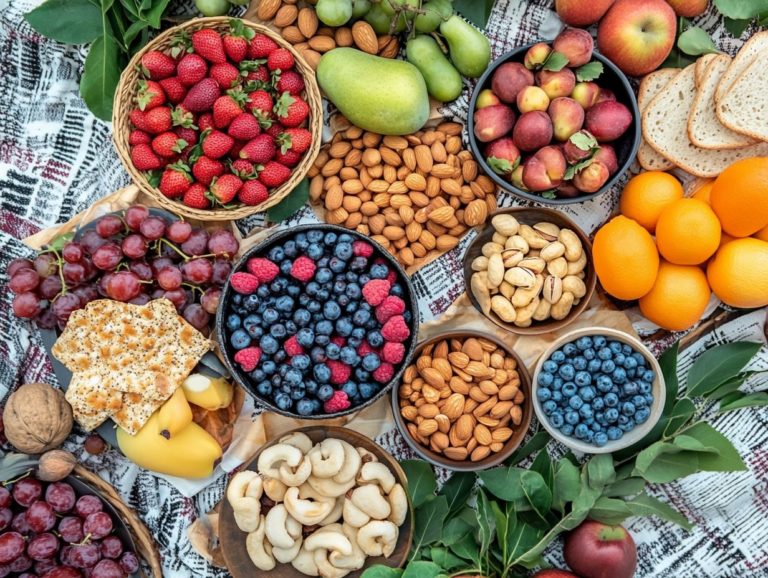5 Best Practices for Healthy Grocery Shopping
Grocery shopping can often feel like navigating a maze, especially when you’re striving to make healthier choices. With an endless array of options and enticing snacks lurking around every aisle, how do you guarantee that your cart is brimming with nutritious foods?
Ready to transform your grocery shopping into a fun and healthy adventure? This article offers five best practices for a better shopping experience, empowering you to make informed decisions. From crafting a solid grocery list to opting for whole foods, you’ll discover essential tips that promote your health and enhance the efficiency of your shopping trips while keeping your budget intact.
Contents
- Key Takeaways:
- 1. Make a List and Stick to It
- 2. Shop the Perimeter of the Store
- 3. Read Nutrition Labels Carefully
- 4. Choose Whole Foods over Processed Foods
- 5. Buy in Bulk and Freeze for Later
- How Can Meal Planning Help with Healthy Grocery Shopping?
- Frequently Asked Questions
- What are the 5 best practices for healthy grocery shopping?
- Why is it important to make a list before grocery shopping?
- What should I prioritize when shopping in the grocery store?
- How can I ensure that I am buying healthy options when reading labels?
- Are there specific foods I should avoid when grocery shopping for a healthy diet?
- How often should I go grocery shopping for healthy food?
Key Takeaways:
- Make a list to avoid impulse buys.
- Shop the perimeter for fresh foods.
- Read nutrition labels for healthier choices.

1. Make a List and Stick to It
Creating a grocery shopping list is a crucial step in your journey to maintain a healthy diet. It helps you focus on purchasing nutritious foods and manage your budget.
A well-crafted list also assists in resisting the temptation to make impulse buys. You can prioritize seasonal produce, which elevates flavor and enhances nutritional value, making your meals effective and enjoyable.
To create a comprehensive list that fosters healthy selections, consider starting with these steps:
- Assess your pantry staples.
- Incorporate a vibrant variety of fruits and vegetables.
- Reference recipes for inspiration.
It s wise to categorize items by department and set a budget limit for each category. This approach helps you reduce costs and ensures essential, wholesome foods remain front and center.
2. Shop the Perimeter of the Store
When grocery shopping, focus on the perimeter of the supermarket to prioritize whole foods. This area includes fresh produce, whole grains, dairy products, and frozen foods essential components of a healthy diet.
By concentrating on the outer aisles, you can fill your cart with vibrant fruits and vegetables bursting with vitamins, minerals, and antioxidants. This method also encourages you to include lean proteins, like chicken and salmon, providing essential amino acids for muscle repair and growth.
Whole grains found on the perimeter, such as quinoa and brown rice, offer the fiber needed to aid digestion and promote fullness. Avoiding the inner aisles helps you steer clear of highly processed foods laden with preservatives and artificial ingredients.
3. Read Nutrition Labels Carefully
Reading nutrition labels meticulously is vital for making informed food choices. This enables you to spot unhealthy ingredients and excessive sodium levels that might undermine your healthy diet.
Understanding key elements like serving size is essential, as it determines the actual amount of calories, fats, and sugars you re consuming. A product might boast low calorie counts, but if the serving size is smaller than what you d typically eat, you could overindulge.
Pay attention to fat content especially saturated and trans fats to guide you toward heart-healthy options. Many products hide sugars that can spike your blood glucose and contribute to weight gain.
To navigate these labels effectively, consider:
- Comparing similar products.
- Prioritizing whole foods.
- Remaining vigilant about added ingredients that may not align with your health objectives.
Start today! Try implementing these tips on your next grocery shopping trip.
4. Choose Whole Foods over Processed Foods

Choosing whole foods over processed options is essential for cultivating a healthy diet. Whole foods provide greater health benefits and contain fewer unhealthy additives, making them your best allies for effective meal preparation.
By selecting fruits, vegetables, nuts, and beans, you can significantly elevate your intake of vital vitamins, minerals, and fiber. These nutrients contribute to your overall well-being.
In contrast, processed foods are often laden with excessive sugars, unhealthy fats, and sodium. These can lead to various health issues, including obesity and heart disease.
To seamlessly incorporate more whole foods into your daily meals, consider starting your day with a vibrant, fruit-packed smoothie. You can also add a colorful salad as a side dish at dinner.
Snacking on raw almonds or crunchy carrot sticks can serve as a nutritious replacement for less healthy options. This ensures a balanced and healthful approach to eating that nourishes both body and mind.
5. Buy in Bulk and Freeze for Later
Want to save money and eat healthier? Buy in bulk and freeze for later! This savvy grocery shopping strategy enables you to save money while ensuring you have long-lasting essentials ready for future meal preparation and cooking.
This approach maximizes your budget and minimizes food waste by keeping perishable goods fresh for an extended period. When you stock up on staples like frozen fruits, chicken, and vegetables, you can take advantage of the lower prices typically offered for larger quantities.
Storing these items properly in airtight containers or freezer bags helps maintain their quality. This ensures they remain flavorful and nutritious when it s time to whip up a meal.
Incorporating frozen foods into your meal planning adds flexibility. You can enjoy quick and easy meals on busy days without compromising on nutrition.
How Can Meal Planning Help with Healthy Grocery Shopping?
Meal planning is an invaluable tool for promoting healthy grocery shopping. It provides you with a clear framework for selecting nutritious foods, organizing your cooking schedule, and reducing food waste.
Meal planning also enables you to make informed choices at the grocery store. By creating a detailed shopping list that aligns with your planned meals, you can streamline your grocery trips and steer clear of impulse buys.
Impulse buys are often culprits that lead to unhealthy choices. This proactive approach increases your chances of purchasing whole foods and ensures that your meals are balanced, incorporating all the necessary food groups.
To develop an effective meal plan, start by assessing your pantry staples. From there, brainstorm recipes that utilize these ingredients.
Craft a list that emphasizes fruits, vegetables, whole grains, and lean proteins. Employing such strategies enhances the overall quality of your diet and supports your personal health goals.
What Are Some Tips for Making a Healthy Grocery List?
Creating a healthy grocery list requires thoughtful planning. Focus on nutritious foods that align with your meal preparation while keeping an eye on your budget.
To achieve this effectively, emphasize the inclusion of fresh produce, whole grains, and lean proteins. By prioritizing seasonal fruits and vegetables, you elevate the flavor of your meals and enhance their nutritional value.
Exploring local farmers markets can open the door to a world of organic offerings while supporting community agriculture. When crafting your list, think about including items like:
- quinoa
- lentils
- seasonal vegetables
These ingredients can be creatively woven into multiple meals throughout the week. This method fosters better health and enriches your culinary journey.
Start your journey toward healthier eating today!
How Can One Avoid Impulse Buys at the Grocery Store?

Avoiding impulse buys at the grocery store requires discipline and effective shopping strategies. These strategies help you stick to your budget and focus on healthy choices.
One of the simplest yet most effective methods you can adopt is to create a detailed grocery list before you head out. This approach not only narrows down your essentials but also prevents you from wandering into aisles brimming with enticing but unnecessary items.
Shopping while satiated significantly reduces cravings. When hunger strikes, the allure of rich, sugary snacks intensifies. Tackling your grocery run during a calm and relaxed mental state rather than when you re feeling stressed fosters more rational decision-making at the checkout.
These strategies help you choose healthier foods and maintain overall budget discipline.
What Are Some Healthy Alternatives to Common Unhealthy Snacks?
Exploring healthy alternatives to common unhealthy snacks can greatly enhance your diet. You can enjoy nutritious options that are both satisfying and budget-friendly while seamlessly supporting your meal preparation efforts.
By opting for roasted nuts instead of traditional chips or fresh fruits rather than sugary pastries, you can maintain stable energy levels throughout your day.
Imagine indulging in a delightful mix of almonds, walnuts, and pumpkin seeds, seasoned with aromatic spices a crunchy treat that far surpasses processed snacks.
Alternatively, picture slicing crisp apples and spreading creamy almond butter on top. This not only satisfies your sweet tooth and delivers a healthy dose of protein.
These mindful choices not only curb cravings but also support weight management and overall well-being, making them perfect companions for a wholesome lifestyle.
How Can One Shop for Healthy Options on a Budget?
Shopping for healthy options on a budget is absolutely within your reach when you employ smart strategies that emphasize seasonal produce, effective meal planning, and using affordable staples like beans and whole grains.
By integrating techniques such as clipping coupons or utilizing cash-back apps, you can significantly reduce your grocery expenses. Buying in bulk can also transform your shopping experience, especially for foods that don t spoil quickly, as it helps you save money in the long run.
Focusing on seasonal fruits and vegetables guarantees fresh and flavorful meals while often coming at a lower price point. With these practical approaches, you can enjoy healthy meals without breaking the bank!
What Are Some Ways to Make Grocery Shopping More Efficient and Stress-Free?
Making grocery shopping more efficient and stress-free depends on adopting effective strategies. This includes planning ahead, crafting a clear list, and confidently navigating the grocery store.
By choosing the right time to shop, you can sidestep long lines and crowded aisles, transforming your experience into a more enjoyable one. Organizing your grocery list according to the store’s layout is another smart move; it saves you time and allows you to gather items systematically without the hassle of backtracking.
Incorporating techniques like batch cooking not only streamlines meal prep for the week but also reduces the number of trips you need to make to the grocery store. Together, these methods help alleviate the anxiety often linked with grocery shopping, turning what might feel like a chore into a well-organized and manageable routine.
Frequently Asked Questions

What are the 5 best practices for healthy grocery shopping?
1. Make a list: Before you head to the store, create a list of healthy items. This will help you avoid impulse buys and stick to your plan.
2. Shop the perimeter: Most healthy foods like fruits, vegetables, and lean proteins are found on the edges of the store. Stay away from processed foods in the center aisles.
3. Read labels: Always check the labels of packaged foods. Pick options with short ingredient lists and minimal added sugars.
4. Choose whole grains: Go for whole grains like whole wheat bread, brown rice, and quinoa. They offer more nutrients and fiber, keeping you fuller for longer.
5. Buy in bulk: Purchasing in bulk can save you money and help you stock up on essentials like nuts, seeds, and whole grains.
Why is it important to make a list before grocery shopping?
Making a list keeps you organized and focused. It helps you avoid impulse purchases and stick to your healthy eating plan.
What should I prioritize when shopping in the grocery store?
Prioritize whole, unprocessed foods such as fruits, vegetables, lean proteins, and whole grains. These foods are full of nutrients and essential for your health.
How can I ensure that I am buying healthy options when reading labels?
Look for products with short ingredient lists and minimal added sugars. Also, check serving sizes and choose options that fit within your calorie and fat goals.
Are there specific foods I should avoid when grocery shopping for a healthy diet?
Avoid processed and packaged foods, as they often contain added sugars and unhealthy fats. However, it s okay to enjoy these occasionally as part of a balanced diet.
How often should I go grocery shopping for healthy food?
Grocery shopping once a week or every 7-10 days is ideal for keeping fresh options at hand. If you have access to a local farmers market, visit more often for fresh produce!






